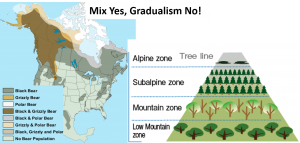 Gradualism is the cornerstone of Darwin’s Theory of Evolution because without it, he could not justify the idea that one organism changes into another. ‘Gradualism’ equals ‘Continuity’ but also presupposes a significant change, not just variations around a static mean (regression to the mean) .
Gradualism is the cornerstone of Darwin’s Theory of Evolution because without it, he could not justify the idea that one organism changes into another. ‘Gradualism’ equals ‘Continuity’ but also presupposes a significant change, not just variations around a static mean (regression to the mean) .
In math, a function is gradual if continuous. A continuous function has a Grade’ (Slope) at every point. If a function is not gradual (continuous), then it is Discrete and has no ‘Grade’ (Slope). A Discontinuous function is a special case of ‘Continuous over limited ranges’. Some argue that large collections of discrete points appear continuous, thus justifying gradualism. This view were acceptable if and only if the contribution of the discrete points were strictly cumulative (such as when many water molecules form water waves).
Is Nature Gradual? No, Nature is Discrete from the most elementary particles, to molecules, cells, and organisms. New organisms are created by discrete processes and result in newborns that are measurably different from each parent while all DNA mutations are discrete events. Gregor Mendel observed the discrete nature of biology as early as 1865 in the inheritance of dominant and recessive alleles. Darwin might have learned that from Mendel’s papers sent to him, had he read and correctly interpreted the results. To be fair, Darwin’s gradualism was in line with the incorrect view of his times that considered matter a continuum. Only in the late 1800s the true discrete nature of matter started to become common knowledge. However, today everyone knows, yet the gradualism hypothesis remains central to evolution despite lacking any basis.
The list of discrete elements in biology includes but is not limited to: atoms, molecules, biochemical reactions, DNA, RNA, proteins, enzymes, genes, chromosomes, organelles, cell types (pro/eukaryote), cell division (mitosis/meiosis), sex type (male/female), body organs, organ systems, and organism classification. Changes at the discrete micro level including mutations and exposure to free radicals, radiation, and misfolded proteins are not cumulative and can potentially impact the entire organism. Continuous measure such as temperature, volume and weight are not true biologic properties as these change over the life of organisms and are primarily statistical measures at population level in particular populations, environments and time.
We classify organisms into distinct groups with little if any overlap and with significant homogeneity within the group. If Gradualism were the norm, all living animals would fill a continuous spectrum which would make their classification in various taxa completely arbitrary. Were gradualism true in time – call this vertical gradualism, then gradualism over the current living – horizontal gradualism – should also be the norm. Instead, we observe that even unicellular organisms with huge populations and short-lived generations do not occupy a biological continuum. Plant diversity over the altitude & latitude continuum is a good example of Discontinuity in Nature: as conditions change, we see a changing mix of distinct species, rather than hybrid species as would be expected if Gradualism were true. Animal territoriality is also an example of discrete successful designs dominating certain ranges and mixing with each other at range boundaries without significantly changing their characteristics.
What about Speciation and Hybridization? And what about the Fossil Record? A certain flexibility appears built into each biological design – more in some than in others. What we call Speciation and Hybridization may in fact be no more than adaptations within these flexibility ranges. Without confirming experiments on living organisms, it is impossible to determine whether the Fossil Record shows Gradualism or instead predisposition to Gradualism prompts an incorrect interpretation of the Fossil Record.
Pro-Con Notes
Con: Individuals heights are gradual. Height is one of the characters Mendel used with his pea plants, and height at maturity is influenced by a host of loci.
Pro: Height is not a proper biologic measure because height changes all the time, not just during development and because it is arbitrarily determined. Just as well you can sort by vertical reach or eyes height (on or off tiptoes), etc. – these can be more important for survival than the standard measurement and will throw off your statistics. Also food/climate/parasites during development affect size at maturity. And when exactly is maturity?
Con: Gradualism is the rule in evolution, since different alleles usually differ in their phenotypes only marginally. Phyletic gradualism does not claim that there is an absolutely smooth spectrum of species change over time.
Pro: Alleles are not gradual as demonstrated by Mendel. Darwin decreed gradualism precisely to support “smooth spectrum of species change over time”. Where do you see gradualism when everything in biology is 100% discrete from sub-atoms to atoms, molecules, genes, chromosomes, each element of cell structure and cell process, sexes, prokaryotes, eukaryotes, dominant-recessive, etc. etc.?
Con: The fossil evidence supports gradual changes in species.
Pro: The fossil record is “evidence” in the same sense animation is “evidence” of real life events.
Con: Is the DNA of a newborn measurably different and a significant leap from a random combination of the DNA of both parents?
Pro: Yes. Darwin’s theory of inheritance was “blended characteristics” (gradualism). That is, the offspring was a “blend” of both parents. The contrary idea of discrete alleles of genes had been found and proven by Mendel that hypothesized instead that traits, such as eye color or height or flower hues, were carried by tiny particles that were inherited whole in the next generation.
Links:
https://phys.org/news/2010-11-darwin-theory-gradual-evolution-geological.html
http://www.pbs.org/wgbh/evolution/library/06/1/l_061_01.html